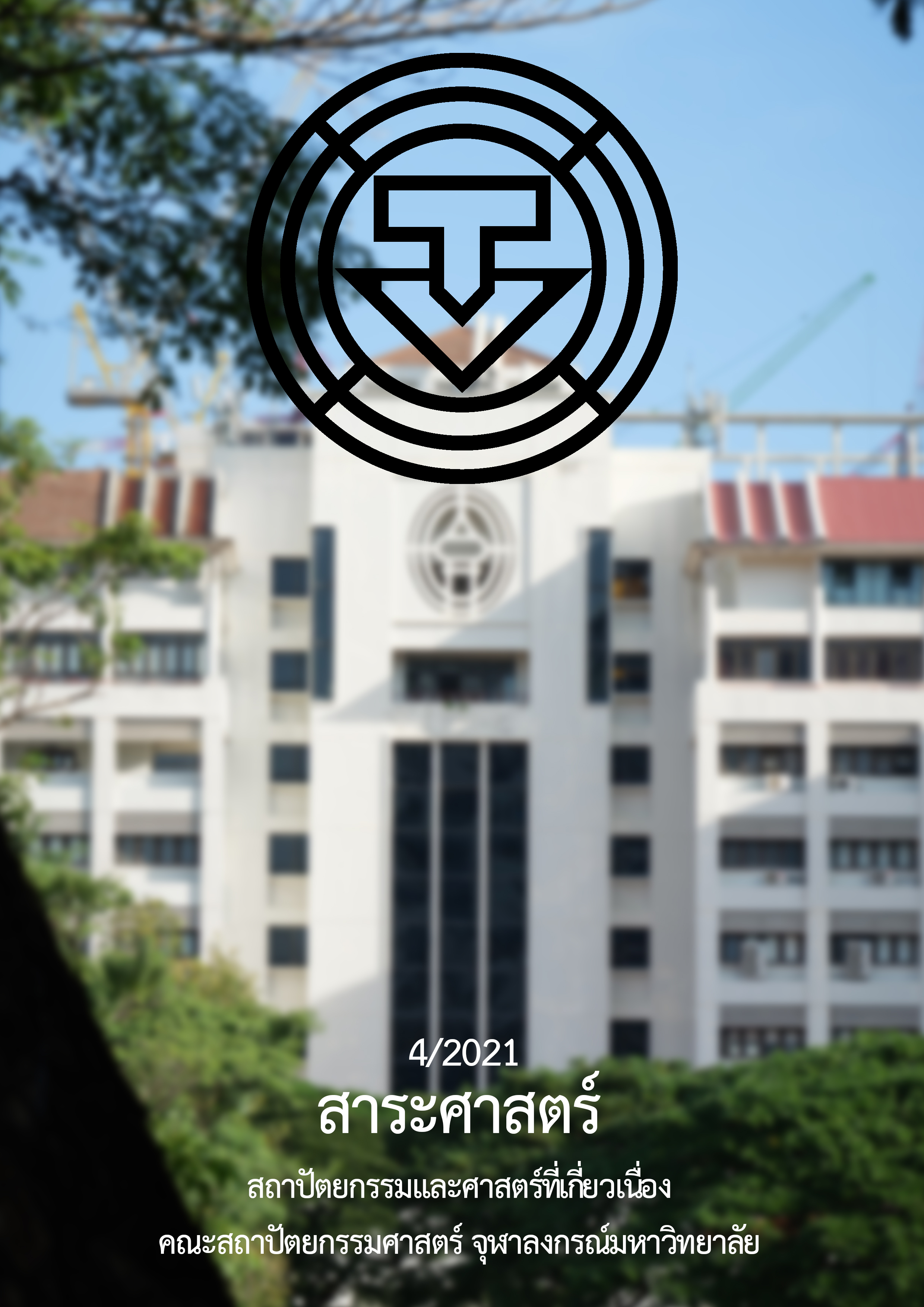The Follow up of Physical Environment Development in Well-Being Workplace: Case Study of Research and Innovation for Sustainability Center (RISC)
Main Article Content
Abstract
At present, the growth and supply of the office building is likely to be highly competitive situation. Then, the office building requires a sustainable development strategy and the health or well-being of building occupants becomes an important issue. Therefore, it is necessary to study the development of the physical environment that promotes health in use. In Thailand, the first well-being workplace that received WELL certification is the Research and Innovation for Sustainability Center (RISC). Thus, this research studied WELL building standard with a survey research study from RISC project as a case study using the project monitoring process.
The result shows that the RISC Project has been developed according to WELL version 1 standard with the Gold level certification. 61 criteria or 59.22% of WELL version 1 criteria in the new and existing interiors category have been conducted. In addition, this research conducted the study of criteria importance level of RISC project. It was found that Air category is the most conducted criteria for both precondition and optimization which equals 30.51% of all conducted criteria. In addition, the Air category was also rated as the most important category which important scale equals 6.52. For Water and Light category, each of which was conducted 11.86 of all conducted criteria. These 2 categories were rated as the second and third important category, which important scales equal 6.37 and 6.26 respectively.
Article Details
References
บริษัท เน็กซัส พรอพเพอตี้ มาร์เก็ตติ้ง จำกัด. (2562). เน็กซัสเผย ตลาดอาคารสำนักงานเกรด A ในกรุงเทพไปได้ดี คาดทยอยเปิดอีก 13 โครงการภายใน 2 ปีข้างหน้า. สืบค้นเมื่อ 18 กรกฎาคม 2563, จาก https://nexus.co.th/news/เน็กซัส-สรุปภาพรวมตลาด
บุญชม ศรีสะอาด. (2535). การวิจัยเบื้องต้น (พิมพ์ครั้งที่ 3). กรุงเทพฯ: สุวีริยาสาส์น.
ภาวดี ธุรวงศ์. (2559). การพัฒนาเกณฑ์การออกแบบอาคารเขียวเพื่อส่งเสริมสุขภาวะสำหรับอาคารที่พักอาศัยแบบยั่งยืนในประเทศไทย. (วิทยานิพนธ์ปริญญามหาบัณฑิต, จุฬาลงกรณ์มหาวิทยาลัย).
ศูนย์วิจัย คอลลิเออร์ส อินเตอร์เนชั่นแนล ประเทศไทย. (2562). ตลาดอาคารสำนักงานยังไม่สะเทือน. สืบค้นเมื่อ 18 กรกฎาคม 2563, จาก https://www.reic.or.th/News/RealEstate/441857
ศูนย์วิจัย ซีบีอาร์อี. (2562). แนวโน้มใหม่ในตลาดอสังหาฯเชิงพาณิชย์ของกรุงเทพฯ. สืบค้นเมื่อ 18 กรกฎาคม 2563, จาก https://www.cbre.co.th/th/news/ bangkok-commercial-properties-facing-new-market
สำนักนโยบายและแผน. กลุ่มงานติดตามและประเมินผล. (2550). คู่มือการติดตามและประเมินผล. สืบค้นเมื่อ 24 กันยายน 2563, จาก https://www.senate.go.th/assets/portals/1/files/manual_assess.pdf
Bonnefoy, X. R., Braubach, M., Moissonnier, B., Monolbaev, K., & Robbel, N. (2003).Housing and health in Europe: Preliminary results of a pan-European study.American Journal of Public Health, 93(9), 1559-1563.
Building and Construction Authority [BCA]. (2013). BCA green mark for new residential buildings version RB/4.1. Singapore: Building and Construction Authority.
Building Research Establishment [BRE]. (2015). Home quality mark: Technical manual SD232: 0.0 (Beta England) – 2015. Watford: BRE Global Ltd.
Building Research Establishment [BRE]. (2016). BREEAM international new construction 2016: Technical manual SD233 1.0. Watford: BRE Global Ltd.
International Living Future Institute [ILFI]. (2014). Living building challenge 3.0 Seattle.Washington: The International Living Future Institute.
International WELL Building Institute [IWBI]. (2020). The WELL building standard version 1. Retrieved from https://www.wellcertified.com/certification/v1/standard
Japan Sustainable Building Consortium [JSBC]. (2008). Comprehensive Assessment System for Building
Environmental Efficiency (CASBEE) for home (detached house)–Technical manual 2007 edition. Tokyo: Institute for Building Environment and Energy Conservation.
Japan Sustainable Building Consortium [JSBC]. (2014). Comprehensive Assessment System for Building Environmental Efficiency (CASBEE) for building (new construction): Technical manual 2014 edition. Tokyo: Japan Institute for Building Environment and Energy Conservation.
Kellert, S. (2005). Building for life: Designing and understanding the human–nature connection. Retrieved from https://www.researchgate.net/publication/40777405
Mendell, M.J., Mirer, A.G., Cheung, K., & Douwes, J. (2011). Respiratory and allergic health effects of dampness, mold, and dampness-related agents: A review of the epidemiologic evidence. Environmental Health Perspectives, 119(6), 748.
Sandel, M., Baeder, A., Bradman, A., Hughes, J., Mitchell, C., Shaughnessy, R., … & Jacobs, D. E. (2010). Housing interventions and control of health-related chemical agents: A review of the evidence. Journal of Public Health Management and Practice, 16(5), S24-S33.
The U.S. Centers for Disease Control and Prevention [CDC]. (2019). Fitwel Standard. Retrieved from https://www.fitwel.org/
U.S. Green Building Council [USGBC]. (2013). LEED reference guide for building design and construction, LEED V4. USGBC. Washington, DC: U.S. Green Building Council.
U.S. Green Building Council [USGBC]. (2020). Reference guide for The WELL Building Standard. Retrieved from https://www.usgbc.org/event/introduction-well-building-standard
Wee, L. E., Koh, G. C., Yeo, W. X., Chin, R. T., Wong, J. & Seow, B. (2013). Screening for cardiovascular disease risk factors in an urban low-income setting at baseline and post intervention: A prospective intervention study. European Journal of Preventive Cardiology, 20, 1-13.
World Health Organization [WHO]. (1995). Constitution of the world health organization. New York: WHO.
World Health Organization [WHO]. (2012). Environmental health inequalities in Europe: Assessment report. Copenhagen: WHO.


